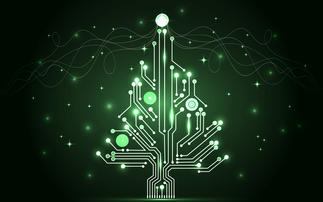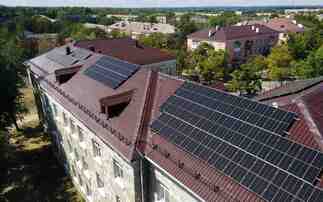
Kelly Becker, Schneider Electric
Industry Voice: An electric and digital world is key to a sustainable and resilient future, explain's Schneider Electric's UK & I zone president Kelly Becker
2022 was supposed to signal a collective move from pledge to action. Organisations had set their ambitious sustainability targets, but unexpected disruptions suddenly became barriers to progress. Widespread supply chain issues, geopolitical conflict, energy price rises and the cost-of-living crisis has created one of the most challenging landscapes for businesses to fulfil their environmental promises.
Organisations may not feel equipped to deliver on net zero targets in the required timeframe; however, a collaborative approach can help track net-zero success. Today, we have an opportunity to revolutionise the way we design, build, operate and maintain our buildings and critical infrastructure with the help of software and smart design from the get-go. We can empower sustainable change through data, electrification, and digitisation, moving into the era of 'Electricity 4.0'.
Embracing Electricity 4.0
Across the world, smart technologies are helping businesses simultaneously improve sustainability and productivity. It is already accepted that electricity is the fastest route to cleaner, smarter, more efficient energy, and the best vector for decarbonisation. Governments and regulators are helping to create the incentives and landscape for change.
We believe that to achieve ambitious net-zero goals, we must focus on Electricity 4.0 - which brings together digital technologies and electricity at scale. By 2030, the booming digital economy will require 50 per cent more power than it consumes today, and bringing digital and electric together will be the answer. Electricity 4.0 drives a fundamental shift in how we measure, use, save and distribute energy. When electricity meets digital, it becomes controlled, visible, connected, and smarter - delivering more and wasting less.
At Schneider Electric, we are investing in smart grids, factories, and retrofitting homes and buildings to achieve meaningful reductions in carbon emissions. We know there is much to do - according to our Powering Change research, only 29 per cent of organisations have started measuring energy use and identifying energy waste. Just a third have mapped their current carbon footprint, while one in six has not started mapping carbon emissions. Investment in smart technologies provides insight and data that empower intelligent decisions and allow businesses to manage their energy effectively. These connected technologies bring together the principles of Electricity 4.0 to deliver on net zero targets.
The Grid of the Future is the key to decarbonise
Embracing Electricity 4.0 is vital for decarbonisation. At Schneider Electric, we use data, automation, and digital solutions to decarbonise the grid and create what we call the 'Grid of the Future' - integrating renewable energy and distributed energy resources into the grid. Smart solutions enable businesses and end consumers to manage their energy more efficiently and effectively, balancing out increased demand without the need for massive increases in spending and grid reinforcements.
With the grid already under so much pressure, the growth in electric vehicles (EVs) could double residential energy usage, acting as a catalyst for a greener grid. Add in electric heating and cooking and the residential market is bracing itself for severe disruption. Scrapping petrol and diesel cars in favour of EVs is a crucial part of decarbonisation and proves the need for investment in charging infrastructure and decentralised grid infrastructure.
Schneider Electric has been connecting the dots to empower our customers and partners to make better-informed advancements in sustainability. We support optimisable bi-directional, decentralised energy flows from battery storage and microgrids for greater energy efficiency. Decarbonising the grid is vital to make a change at a significant scale, at the pace required.
Harnessing data reduces energy waste
At its core, the climate change issue is an energy issue. Over 80 per cent of global CO2 emissions come from the production and consumption of energy, with even the tiniest amount of energy waste creating a considerable impact. Energy, just like every other commodity, has its value chain. To fight climate change, we must re-evaluate every stage of that chain and eliminate waste wherever possible.
Historically, energy has been linear in design. The chain starts at the supply, producing energy in huge quantities from large fossil-fuelled power stations, a primary contributor to carbon emissions. The energy produced was distributed over vast distances to points of consumption that would then use the available energy. This production, distribution and consumption led to a massive 60 per cent inefficiency, or waste, of energy.
Global energy demand will only continue to grow, driven by population, economic growth and electrification, and we must sustain that demand while curbing emissions. We must focus on reducing energy waste and increasing resilience; digital technology is critical. It enables us to see how energy is used, making the invisible visible so we can reduce the vast amount of waste. With this data, businesses can pinpoint where to make changes to reduce emissions and save the planet.
Despite being one of the fastest ways to reduce consumption, energy efficiency is often overlooked but is vital to improving productivity and decarbonisation. We at Schneider Electric believe a more electric and digital world is key to a sustainable and resilient future. It can be daunting for businesses to know where to start, but we are in this together. With our customers, we are building the New Electric World, providing smart energy everywhere in homes, buildings, data centres, industries, infrastructure, and grids. Businesses must strategise - to build a decarbonisation roadmap. Digitise - to monitor operations and identify saving opportunities. And decarbonise - by electrifying operations to reduce costs and energy consumption. This isn't the distant future. This is happening today, and we must all get our energy management in order.
Kelly Becker is UK&I zone president at Schneider Electric.
This article is sponsored by Schneider Electric.







